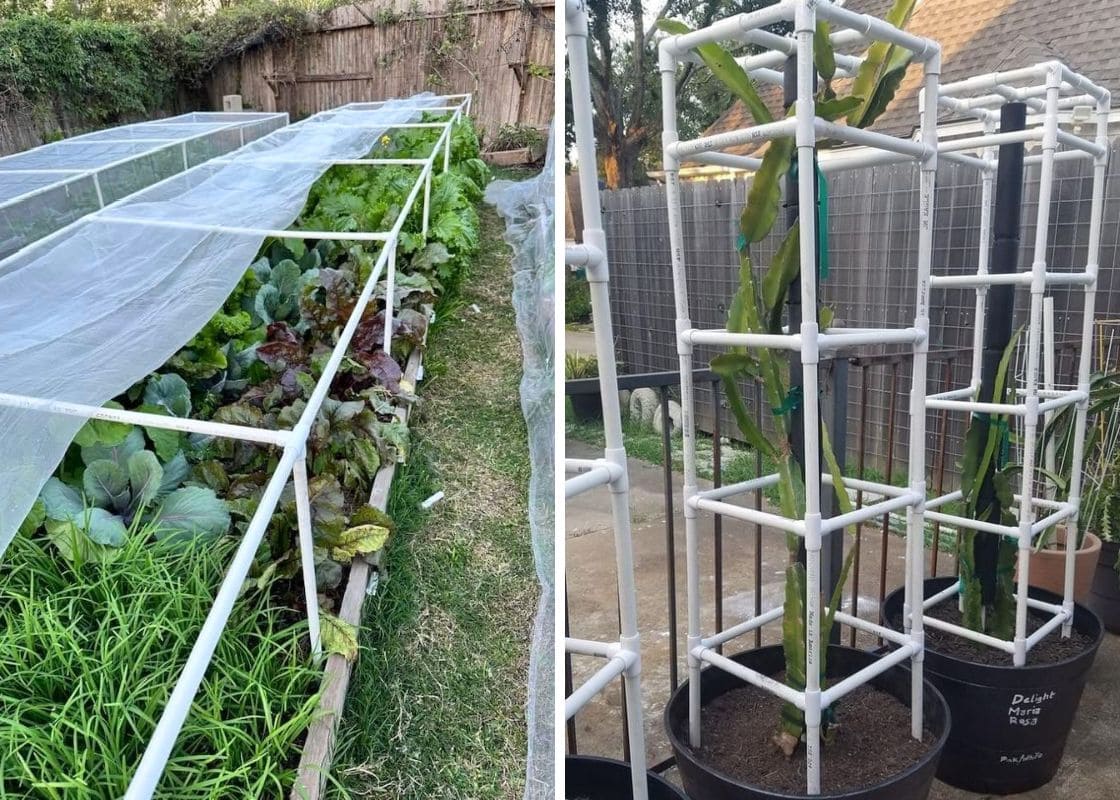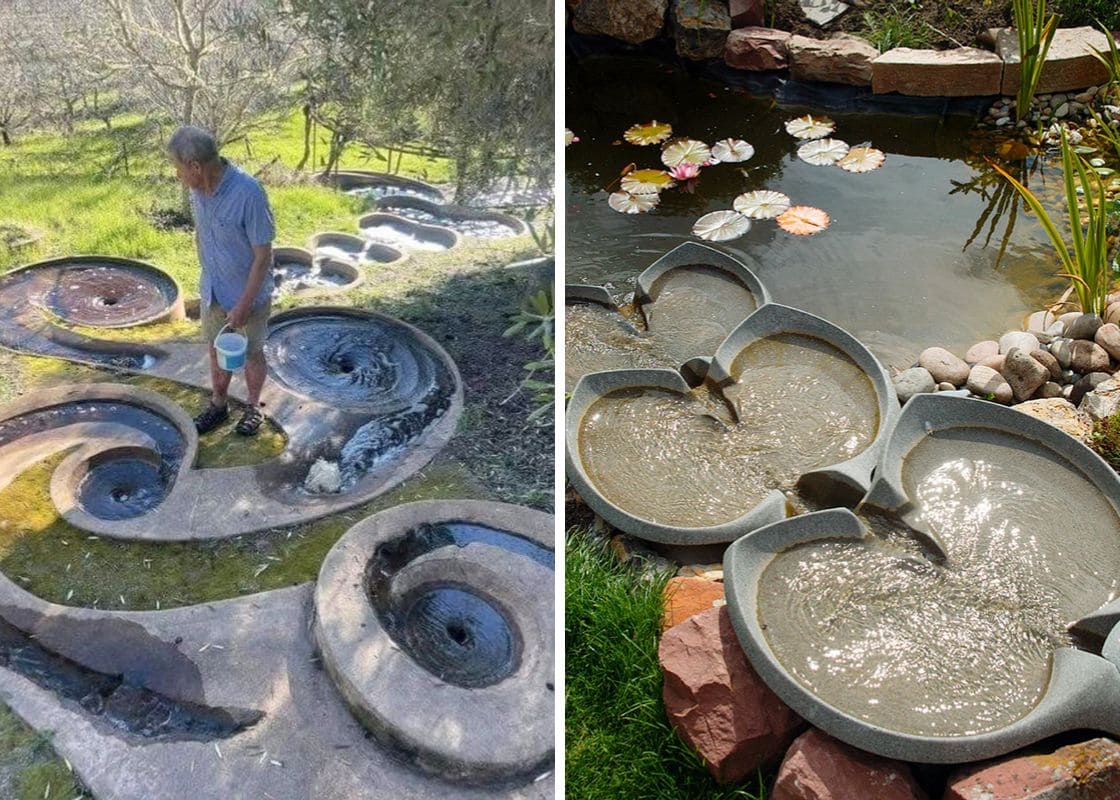White-flowering plants are frequently disregarded in landscape design due to their lack of vibrancy.
However, white flowers can effectively brighten up dark areas of the garden and serve as a neutral color in mixed plantings, enhancing the vibrancy of brighter hues.
Additionally, they can be utilized to tone down the impact of bold color schemes or create a striking effect in a monochromatic scheme, such as an all-white garden.
Rose (Rosa)
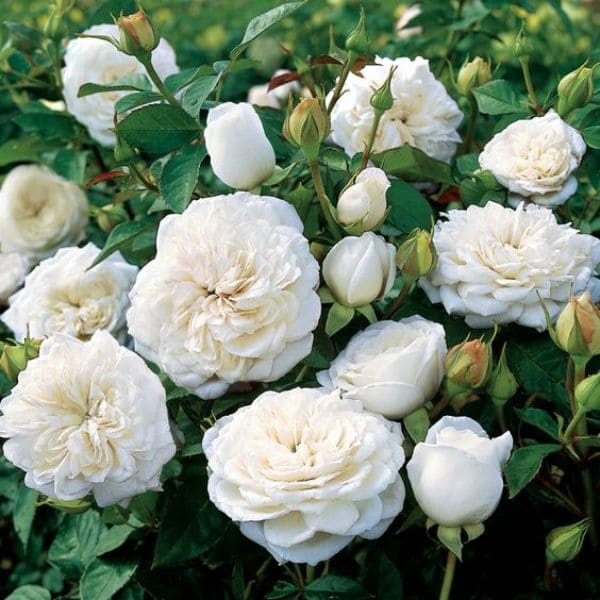
- Plant Type: Perennial
- Bloom Time: Spring to Fall
- Sun Exposure: Full sun
- Soil Requirement: Well-drained, fertile soil
- USDA Hardiness Zones: 3-11
- Native: Asia, Europe, North America
The white rose is a timeless beauty in the garden, often symbolizing purity, innocence, and new beginnings.
This perennial plant, known for its elegant appearance, typically grows to a height of 2-6 feet, with some varieties reaching up to 20 feet when climbing.
Its delicate petals, often exceeding 30 in count, form lush, full blooms that captivate with their classic charm.
White roses thrive best in full sun and benefit from regular watering and mulching. Besides, pruning is essential to maintain their shape and encourage new growth.

Beyond their garden appeal, white roses are popular in floral arrangements, weddings, and symbolically in various ceremonies. Their versatility also includes use in perfumes and skincare products.
Lily (Lilium)
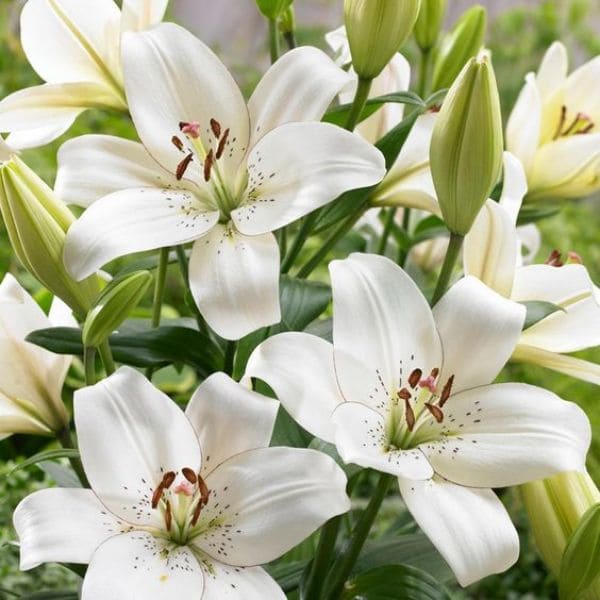
- Plant Type: Perennial
- Bloom Time: Early to mid-summer
- Sun Exposure: Full sun to partial shade
- Soil Requirement: Well-drained, slightly acidic to neutral soil
- USDA Hardiness Zones: 3-9
- Native: Northern Hemisphere (Asia, Europe, North America)
The white lily is a striking addition to any garden, symbolizing purity, renewal, and rebirth. This elegant perennial stands tall, typically reaching heights of 2-6 feet.
Its trumpet-shaped flowers boast six pristine white petals, often speckled or streaked, and a captivating fragrance that fills the air with a sweet, intoxicating scent.
White lilies thrive in well-drained, rich soil and prefer full sun to partial shade. They bloom in early to mid-summer, offering a stunning display of beauty during the warmer months.

Additionally, white lilies are popular in floral arrangements and are often used in weddings and religious ceremonies.
Notably, lilies are also deer-resistant, making them an excellent choice for gardens prone to wildlife visits.
Orchid (Orchidaceae)
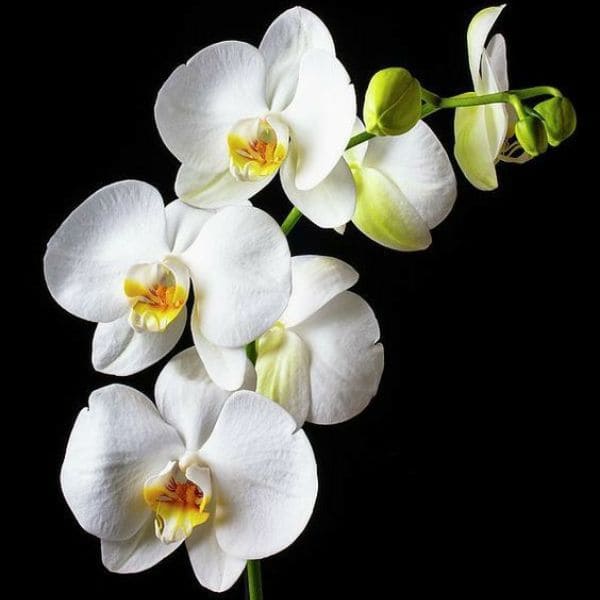
- Plant Type: Perennial
- Bloom Time: Varies by species; generally spring to fall
- Sun Exposure: Indirect light to partial shade
- Soil Requirement: Well-draining, orchid-specific mix
- USDA Hardiness Zones: 6-9 (varies by species)
- Native: Tropical and subtropical regions worldwide
The white orchids typically feature three petals and three sepals, forming a symmetrical and mesmerizing appearance with subtle, sweet fragrance.
White orchids thrive in indirect sunlight and require a well-draining orchid mix to prevent root rot.
Regular watering and periodic feeding with orchid-specific fertilizer ensure healthy growth and vibrant blooms.
Symbolizing purity, elegance, and beauty, white orchids are popular in wedding bouquets, as houseplants, and in sophisticated floral arrangements.
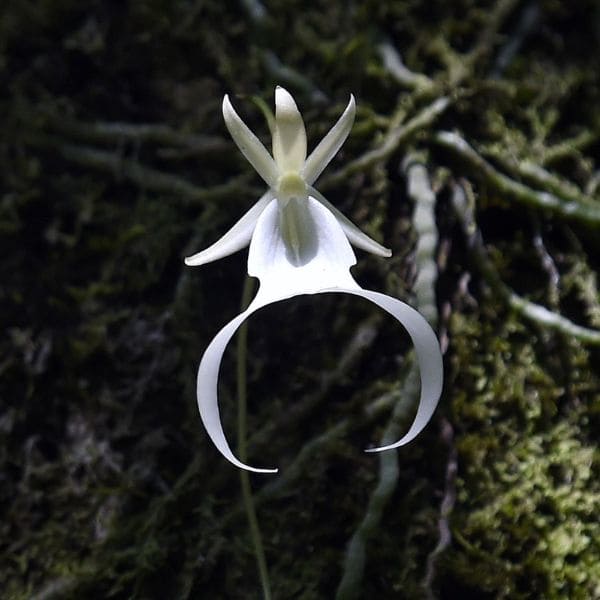
In addition, one rare species of white orchid is the ghost orchid. Native to Florida and Cuba, this elusive beauty is known for its ethereal white flowers that appear to float in mid-air.
The ghost orchid is exceptionally rare, with fewer than 2,000 plants estimated to exist in the wild due to its specific growing requirements and habitat destruction.
Daisy (Bellis perennis)

- Plant Type: Perennial
- Bloom Time: Spring to fall
- Sun Exposure: Full sun to partial shade
- Soil Requirement: Well-drained, average soil
- USDA Hardiness Zones: 4-8
- Native: Europe
The white daisy is a beloved symbol of innocence and purity with subtle fragrance.
This perennial plant typically grows to a height of 6-12 inches, featuring a bright yellow central disc surrounded by numerous white petals, creating a classic and appealing look.
White daisies bloom from spring to fall, providing a long-lasting display of beauty throughout the growing season.
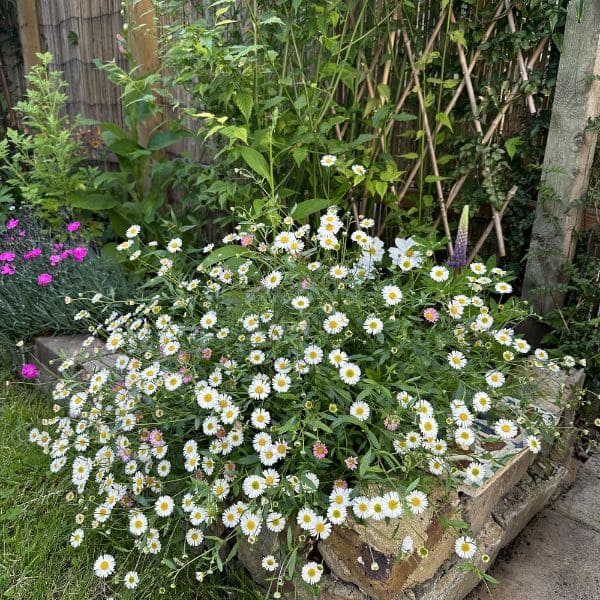
They are popular in bouquets, garden borders, and wildflower meadows. Their simplicity and resilience make them a favorite among gardeners of all levels.
Additionally, the daisy can attract pollinators like bees and butterflies to enhance both beauty and biodiversity.
Jasmine (Jasminum)
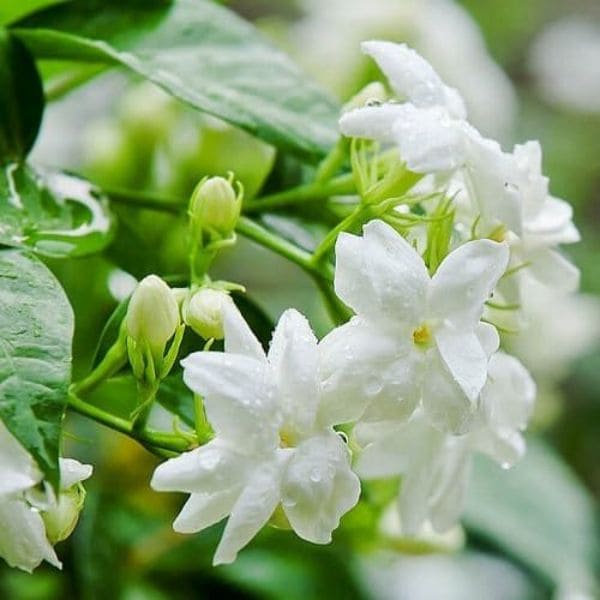
- Plant Type: Perennial
- Bloom Time: Summer to fall
- Sun Exposure: Full sun to partial shade
- Soil Requirement: Well-drained, moderately fertile soil
- USDA Hardiness Zones: 7-10
- Native: Asia, Africa, Europe
Jasmine vines can grow up to 10-15 feet, draping elegantly over trellises and arbors.
Each delicate flower consists of five to nine petals, forming star-shaped blooms that are as visually stunning as they are aromatic.
White jasmine is quite easy to care for but you need water and fertilizer occasionally to help maintain healthy growth.
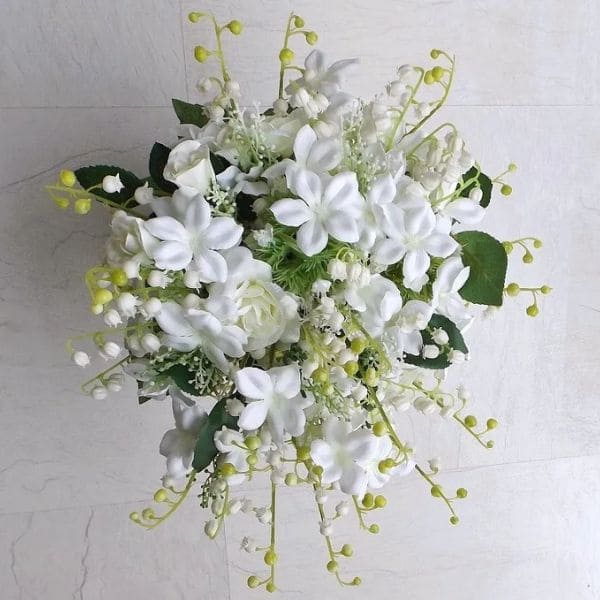
Symbolizing purity, love, and beauty, white jasmine is a popular choice for gardens, bouquets, and aromatherapy. Its sweet, strong fragrance is often used in perfumes and essential oils.
Additionally, jasmine is friendly to the garden because it can attract a lot of pollinators like bees and butterflies.
Gardenia (Gardenia jasminoides)
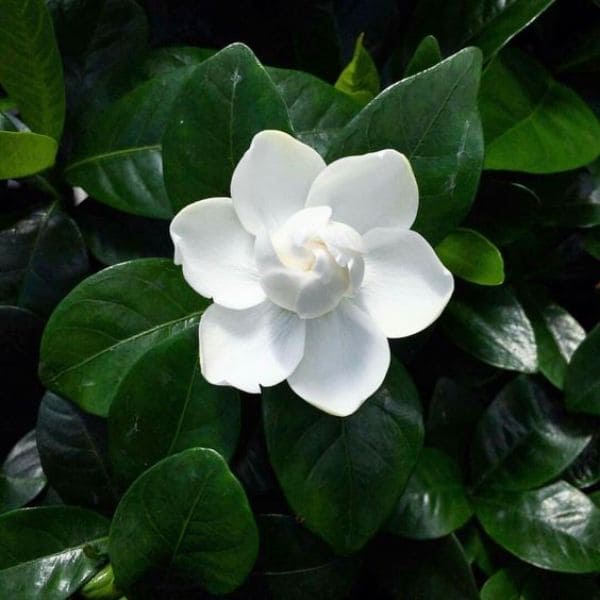
- Plant Type: Perennial shrub
- Bloom Time: Late spring to early summer
- Sun Exposure: Partial shade to full sun
- Soil Requirement: Well-drained, acidic soil
- USDA Hardiness Zones: 8-11
- Native: Asia
This perennial shrub is known for its lush, glossy green leaves and stunning white blooms. Gardenias typically grow to a height of 3-8 feet, making them ideal for hedges and borders.
Each flower boasts an exquisite, creamy white appearance with numerous petals forming a beautiful rosette. The fragrance of gardenia is sweet, often considered one of the finest in the floral world.
When caring for gardenia, remember to prune after blooming helps maintain their shape and encourages new flowers.
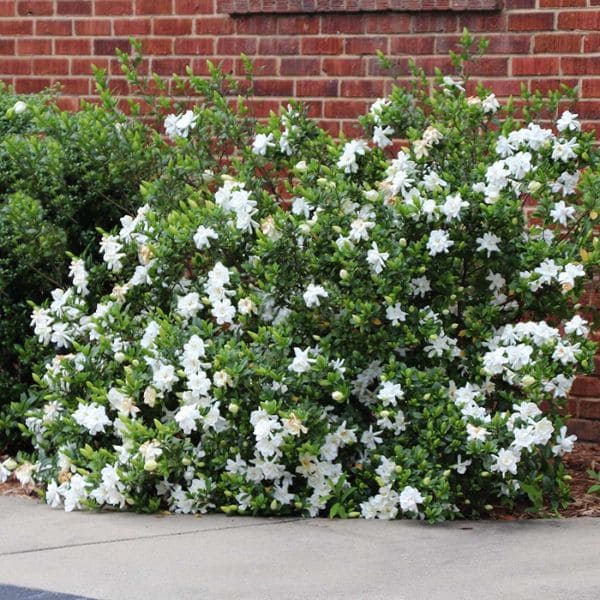
Symbolizing purity, love, and refinement, white gardenias are popular in wedding bouquets, perfumes, and ornamental gardening.
Interestingly, in the Victorian era, they were often given as a gesture of secret love or admiration. Moreover, gardenia extract is known for its potential health benefits, including anti-inflammatory and antioxidant properties.
Hydrangea (Hydrangea macrophylla)
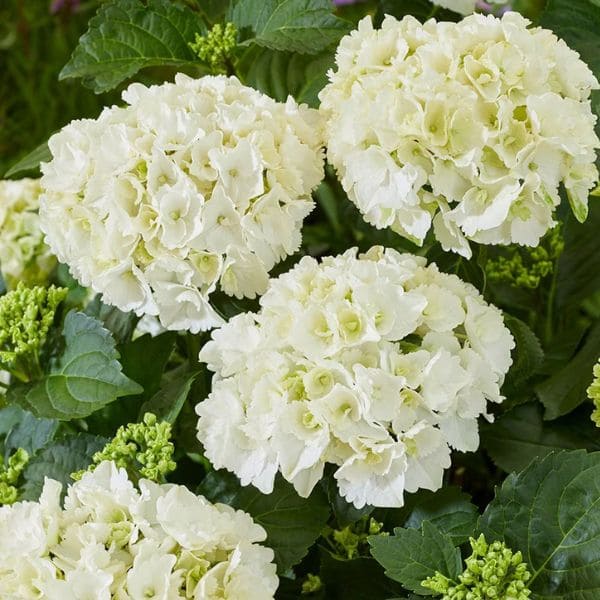
- Plant Type: Deciduous shrub
- Bloom Time: Late spring to early autumn
- Sun Exposure: Partial shade to full sun
- Soil Requirement: Well-drained, moist soil
- USDA Hardiness Zones: 5-9
- Native: Japan, Korea, China
The white hydrangea is a deciduous shrub known for its large, spherical flower clusters. Each cluster is composed of numerous small, star-shaped petals, creating a cloud-like effect.
White hydrangeas thrive in partial shade to full sun and prefer well-drained, moist soil. Besides, you need to prune in late winter or early spring to promote healthy growth.
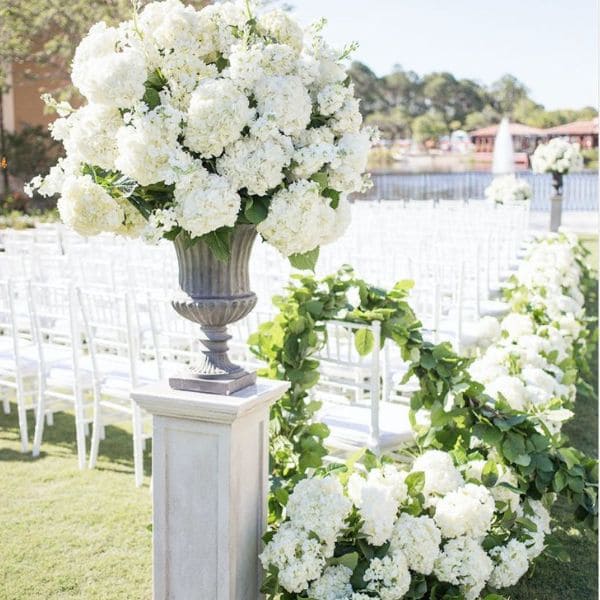
Symbolizing grace, beauty, and abundance, white hydrangeas are popular in floral arrangements, wedding decor, and garden landscapes.
While white is a classic choice, hydrangeas can change color based on soil pH – a fascinating trait known by few. Acidic soil turns them blue, while alkaline soil shifts them to pink, showcasing nature’s own magic trick.
Magnolia (Magnolia grandiflora)
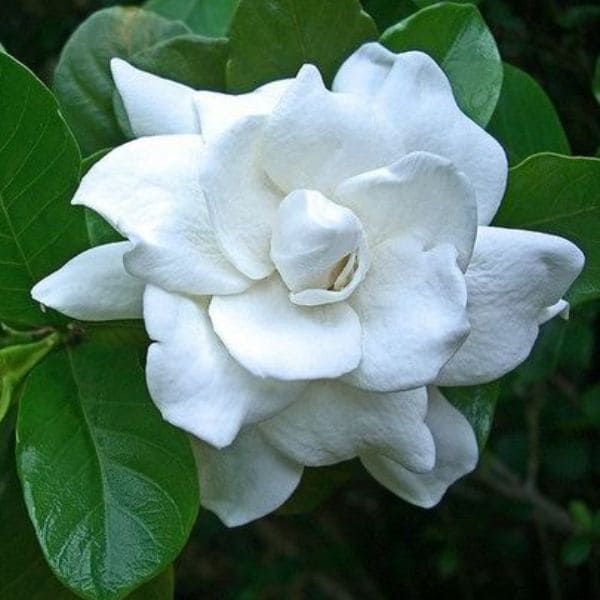
- Plant Type: Evergreen tree
- Bloom Time: Late spring to summer
- Sun Exposure: Full sun to partial shade
- Soil Requirement: Well-drained, slightly acidic to neutral soil
- USDA Hardiness Zones: 6-10
- Native: Southeastern United States
This evergreen tree is renowned for its large, creamy white flowers and glossy, dark green leaves with impressive heights of 60-80 feet.
Each flower, composed of 6-12 thick, waxy petals, exudes a sweet, lemony fragrance that is simply enchanting.
White magnolias prefer well-drained, slightly acidic to neutral soil. Occasionally, you should mulch and feed with a balanced fertilizer to ensure healthy growth and abundant blooms.
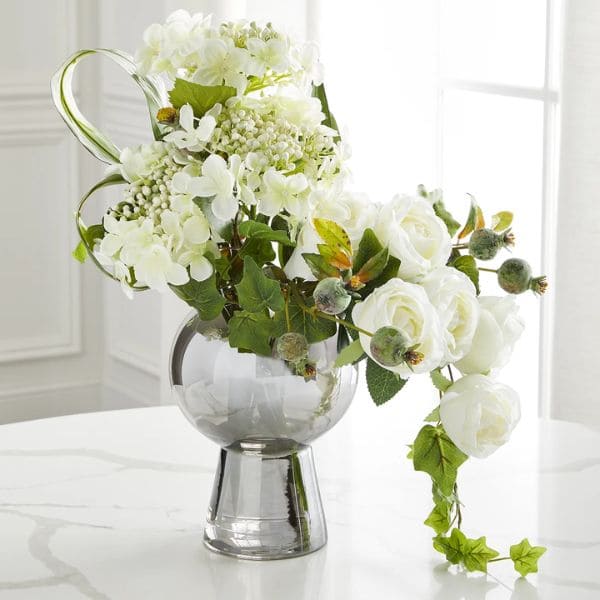
Symbolizing dignity, perseverance, and beauty, white magnolias are often used in grand floral arrangements, wedding decor, and as focal points in garden landscapes.
Interestingly, magnolia trees are ancient plants that have existed for millions of years, long before bees appeared. They were originally pollinated by beetles.
Peony (Paeonia lactiflora)
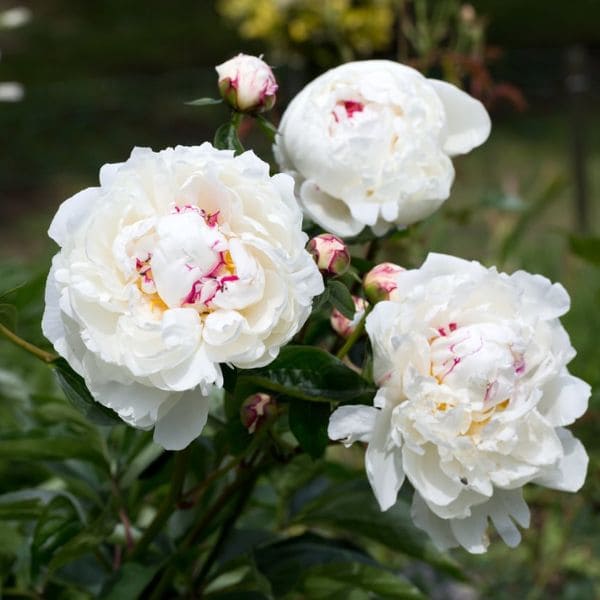
- Plant Type: Herbaceous perennial
- Bloom Time: Late spring to early summer
- Sun Exposure: Full sun to partial shade
- Soil Requirement: Well-drained, fertile soil
- USDA Hardiness Zones: 3-8
- Native: Asia, Europe, Western North America
This herbaceous perennial is celebrated for its large, lush blooms and elegant appearance. Its fragrance is sweet and subtly enticing, often reminiscent of fresh-cut roses.
Peonies typically grow to a height of 2-4 feet, featuring an abundance of ruffled petals that can number up to 60 per flower. The
White peonies thrive in full sun to partial shade and prefer well-drained, fertile soil. They benefit from staking to support their heavy flowers and should be divided every few years to maintain vigor.
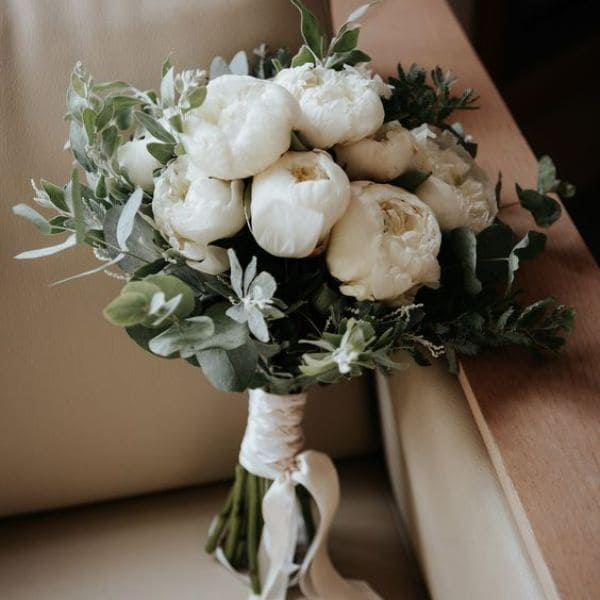
Symbolizing romance, prosperity, and good fortune, white peonies are popular in bridal bouquets, floral arrangements, and as ornamental garden plants.
Additionally, some peony plants can live and bloom for over 100 years if properly cared for.
Camellia (Camellia japonica)
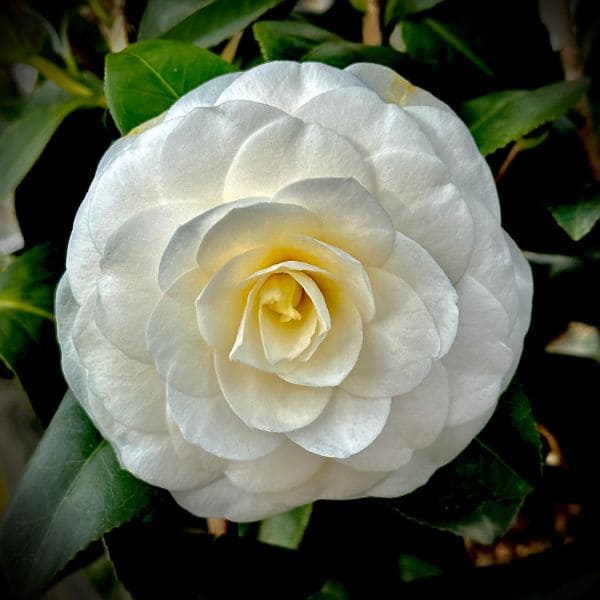
- Plant Type: Evergreen shrub
- Bloom Time: Late winter to early spring
- Sun Exposure: Partial shade
- Soil Requirement: Well-drained, acidic soil
- USDA Hardiness Zones: 7-9
- Native: Japan, China, Korea
This evergreen shrub is renowned for its stunning, waxy blooms and glossy, dark green leaves.
Each flower features numerous, delicately arranged petals, often exceeding 30, forming a symmetrical and captivating blossom.
White camellias thrive in partial shade and prefer well-drained, acidic soil. Besides, pruning should be done after flowering to maintain their shape and promote healthy growth.
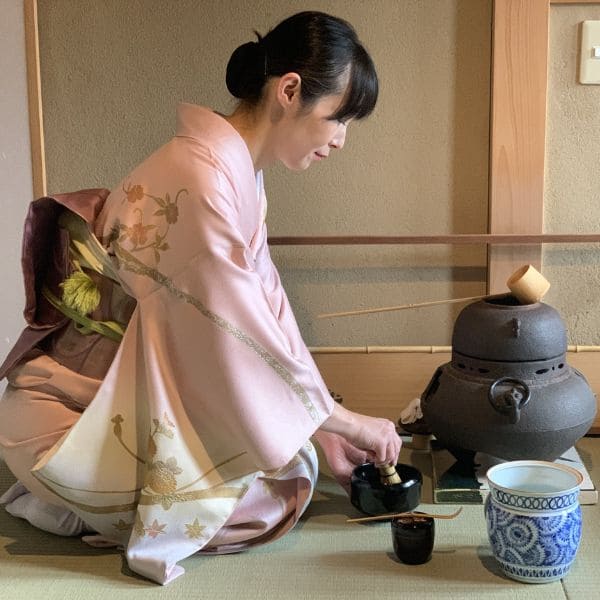
Symbolizing purity, admiration, and perfection, white camellias are popular in floral arrangements, as garden focal points, and in ceremonial uses.
Additionally, in Japanese tea culture, camellias are known as “Tsubaki” and symbolize the arrival of spring. Moreover, camellia oil, extracted from the seeds, has been used for centuries in Asia for hair and skincare.
Anemone (Anemone coronaria)
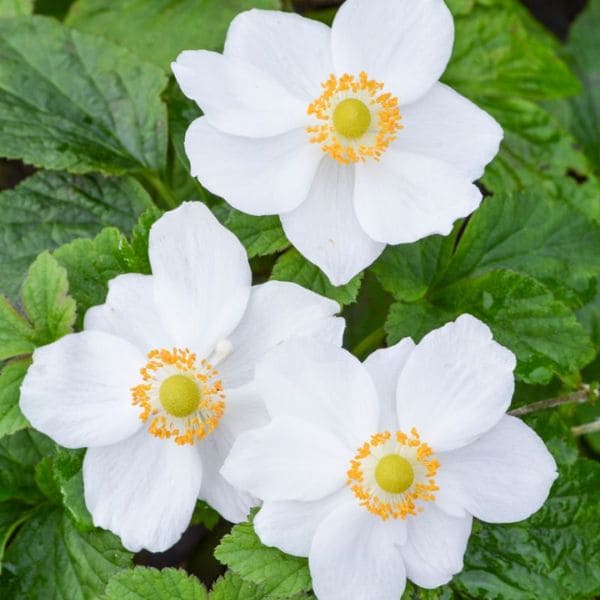
- Plant Type: Perennial
- Bloom Time: Spring to early summer, fall
- Sun Exposure: Full sun to partial shade
- Soil Requirement: Well-drained, sandy or loamy soil
- USDA Hardiness Zones: 7-10
- Native: Mediterranean region
This perennial plant is known for its delicate, poppy-like flowers and fern-like foliage.
White anemones typically reach a height of 12-18 inches, featuring five to eight petals surrounding a dark center, creating a striking contrast.
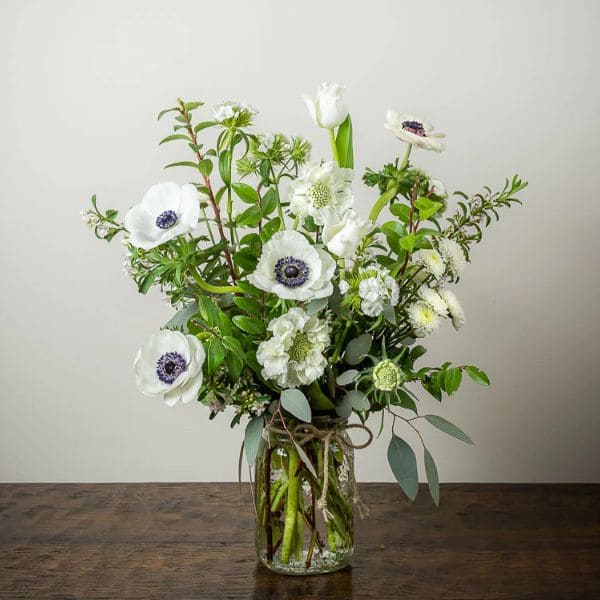
Symbolizing anticipation, purity, and protection, white anemones are popular in floral arrangements and as garden accents.
In ancient times, they were believed to ward off pests and disease. Additionally, the name “anemone” is derived from the Greek word for “wind,” as the delicate flowers sway gracefully with the slightest breeze.
Daffodil (Narcissus)

- Plant Type: Perennial bulb
- Bloom Time: Early spring
- Sun Exposure: Full sun to partial shade
- Soil Requirement: Well-drained, moderately fertile soil
- USDA Hardiness Zones: 3-9
- Native: Europe, North Africa, and Asia
This perennial bulb typically grows to a height of 12-18 inches, featuring six petal-like tepals surrounding a central trumpet or cup with light and sweet fragrance.
Regular watering during the growing season and allowing the foliage to die back naturally ensures healthy bulbs for the next year.

White daffodils are a symbol of rebirth and new beginnings and they are popular in gardens, borders, and as cut flowers.
Besides, they can deter pests as they contain lycorine, a substance toxic to many animals. Especially, the name “daffodil” is thought to be derived from an earlier “affodell,” a variant of Asphodel, the flower of the underworld in Greek mythology.
Chrysanthemum (Chrysanthemum morifolium)
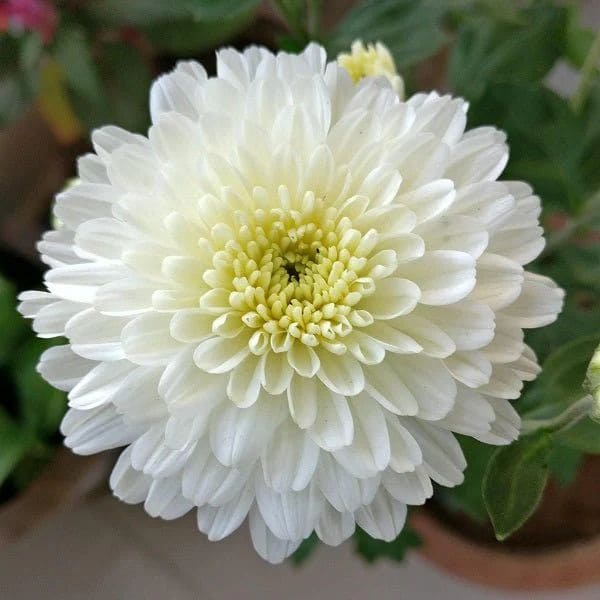
- Plant Type: Perennial
- Bloom Time: Late summer to fall
- Sun Exposure: Full sun
- Soil Requirement: Well-drained, moderately fertile soil
- USDA Hardiness Zones: 5-9
- Native: Asia, particularly China and Japan
Chrysanthemums typically reach a height of 1-3 feet, featuring a multitude of petals arranged in a captivating, symmetrical pattern.
They thrive in full sun and bloom from late summer to fall, bringing a burst of brightness as the growing season wanes.
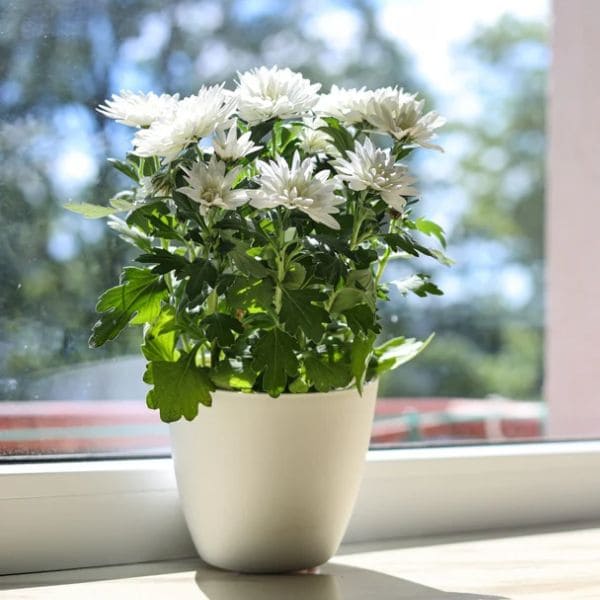
Symbolizing loyalty, purity, and longevity, white chrysanthemums are popular in floral arrangements, garden beds, and as potted plants.
In traditional Chinese medicine, chrysanthemum tea is believed to have cooling properties and to aid in reducing fever.
Additionally, in Japan, the chrysanthemum is the emblem of the Imperial family and represents the sun, further enhancing its cultural significance.
Tulip (Tulipa)
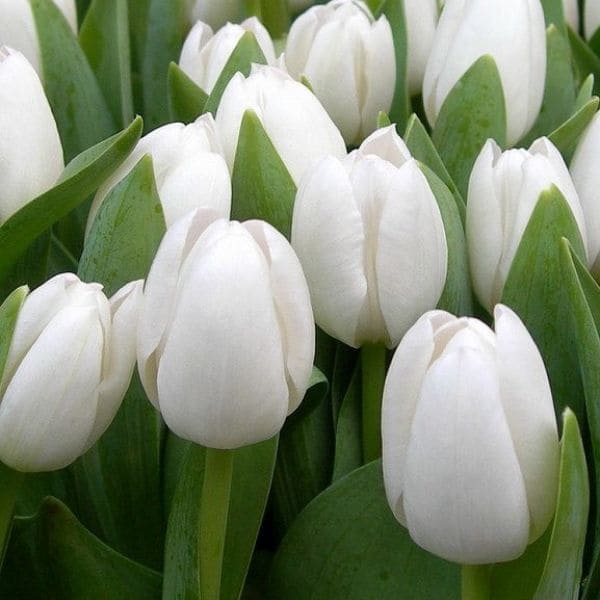
- Plant Type: Bulbous perennial
- Bloom Time: Early to late spring
- Sun Exposure: Full sun
- Soil Requirement: Well-drained, fertile soil
- USDA Hardiness Zones: 3-8
- Native: Central Asia
This bulbous perennial is known for its sleek, cup-shaped blooms. Tulips typically grow to a height of 10-24 inches, featuring six petals that form a symmetrical and eye-catching flower.
In late spring, tulips bloom heralding the arrival of warmer days.
Symbolizing purity, forgiveness, and respect, white tulips are popular in garden beds, borders, and floral arrangements.
During the 17th century in the Netherlands, a period known as “Tulip Mania,” where these flowers became highly prized and were even used as currency.
Snowdrop (Galanthus nivalis)

- Plant Type: Bulbous perennial
- Bloom Time: Late winter to early spring
- Sun Exposure: Partial shade to full sun
- Soil Requirement: Well-drained, moist soil
- USDA Hardiness Zones: 3-8
- Native: Europe and the Middle East
The white snowdrop is a charming herald of spring celebrated for its delicate, nodding flowers that emerge even through the snow, signaling winter’s end.
Snowdrops typically grow to a height of 4-6 inches, featuring three outer petals and three smaller inner petals, often marked with green tips.
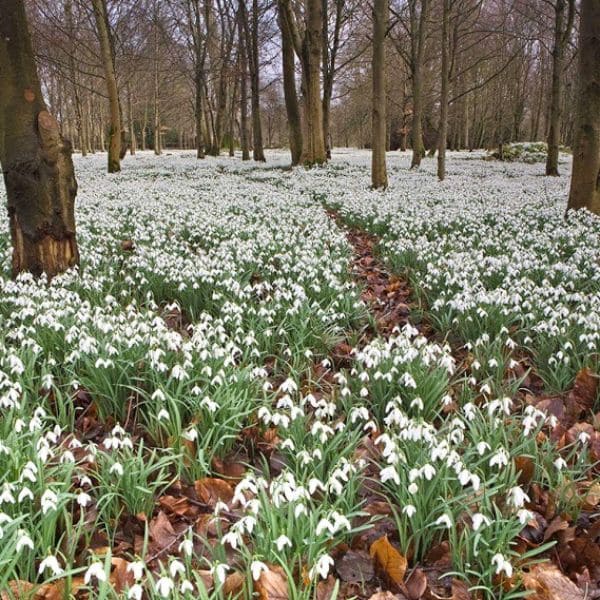
Snowdrops are best planted in the fall, allowing them to establish roots before winter; they are also popular in woodland gardens, borders, and naturalized areas.
Additionally, snowdrops contain galantamine, a compound used in the treatment of Alzheimer’s disease.
Azalea (Rhododendron)
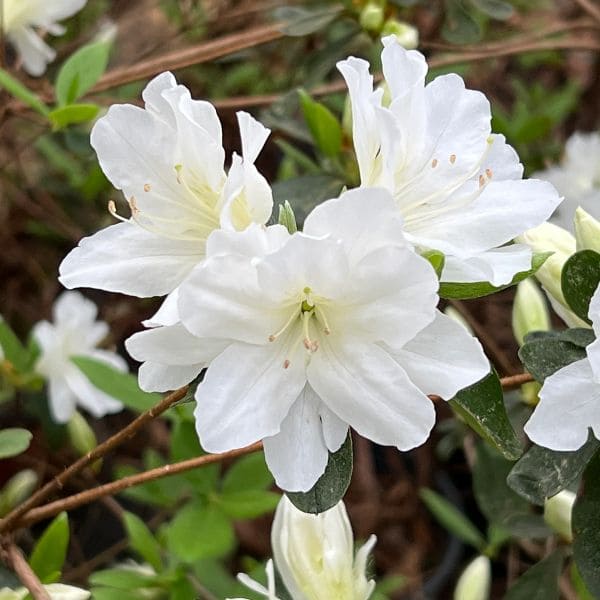
- Plant Type: Evergreen or deciduous shrub
- Bloom Time: Spring
- Sun Exposure: Partial shade to full sun
- Soil Requirement: Well-drained, acidic soil
- USDA Hardiness Zones: 6-9
- Native: Asia, Europe, North America
White azaleas typically grow to a height of 3-6 feet with a profusion of delicate petals, creating a lush, full appearance.
When caring for azaleas, you should water regularly, mulch, and feed with an acidic fertilizer are essential for maintaining their health and vigor.

Symbolizing elegance, purity, and temperance, white azaleas are popular in garden beds, borders, and as standalone specimens.
Furthermore, in Japan, they are often planted around homes to signify domestic happiness.
Begonia (Begonia semperflorens)
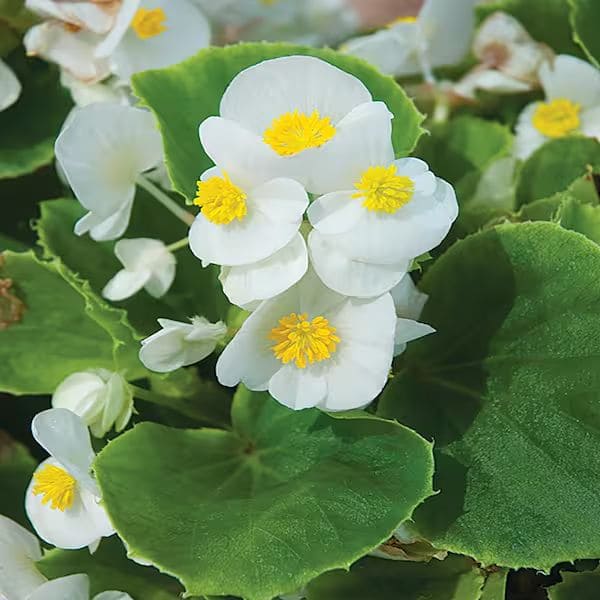
- Plant Type: Perennial (often grown as an annual)
- Bloom Time: Late spring to early autumn
- Sun Exposure: Partial shade to full sun
- Soil Requirement: Well-drained, fertile soil
- USDA Hardiness Zones: 10-11 (grown as annual elsewhere)
- Native: South America
White begonias typically reach a height of 6-12 inches, featuring soft, rounded petals that create a lush, full appearance.
They thrive in partial shade to full sun and you should pinch back stems regularly to encourage bushier growth and more abundant blooms.
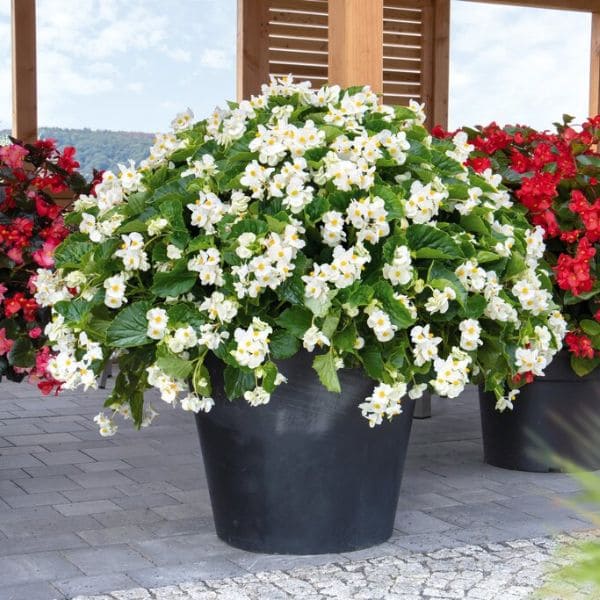
Symbolizing gratitude, purity, and innocence, white begonias are popular in garden beds, containers, and as border plants.
In addition, some cultures use begonia leaves to treat various ailments, including digestive issues and inflammation.
Nicotiana (Nicotiana alata)
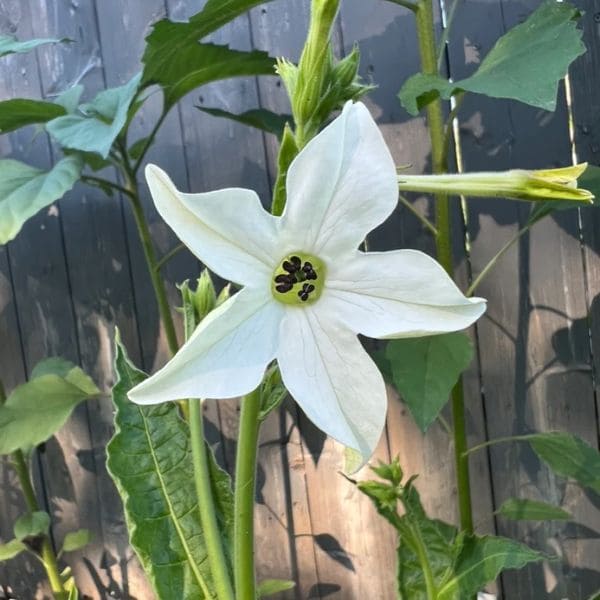
- Plant Type: Annual (in cooler climates) or perennial (in warmer climates)
- Bloom Time: Summer to early autumn
- Sun Exposure: Full sun to partial shade
- Soil Requirement: Well-drained, fertile soil
- USDA Hardiness Zones: 10-11 (grown as annual elsewhere)
- Native: South America
White nicotiana plants typically grow to a height of 3-5 feet, featuring five delicate petals that form a star-shaped bloom.
The sweet, jasmine-like scent of these flowers is particularly strong in the evening, attracting night pollinators such as moths.
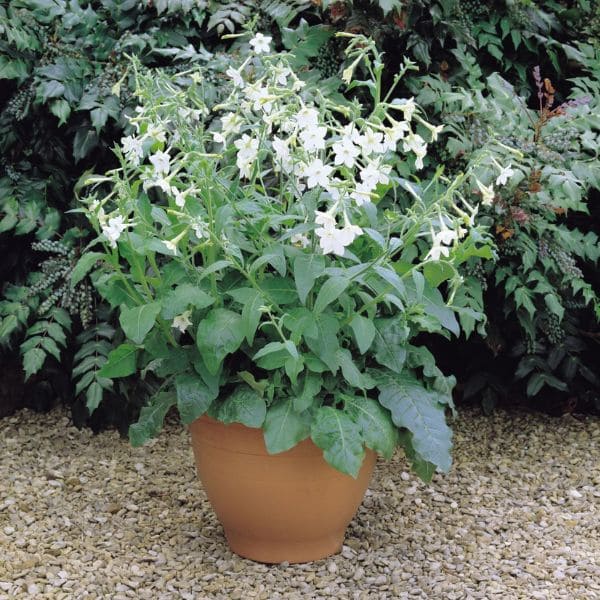
Symbolizing peace, beauty, and charm, white nicotiana is popular in garden beds, borders, and containers.
Additionally, in history, they were used by indigenous peoples for ceremonial purposes and act as a natural insect repellent.
Stephanotis (Stephanotis floribunda)
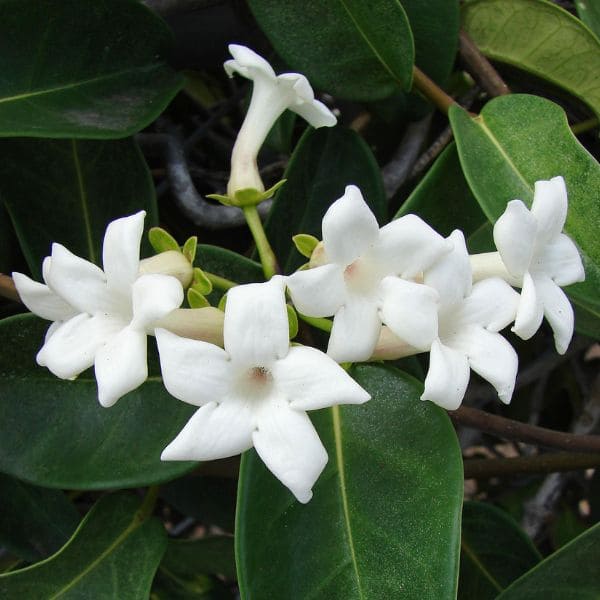 Stephanotis
Stephanotis- Plant Type: Evergreen vine
- Bloom Time: Spring to autumn
- Sun Exposure: Full sun to partial shade
- Soil Requirement: Well-drained, fertile soil
- USDA Hardiness Zones: 10-11
- Native: Madagascar
This evergreen vine is celebrated for its glossy, dark green leaves and star-shaped, waxy white flowers emitting a sweet, jasmine-like aroma that intensifies in the evening.
Stephanotis can climb to heights of 10-20 feet with support, showcasing clusters of five-petaled blooms. highly.
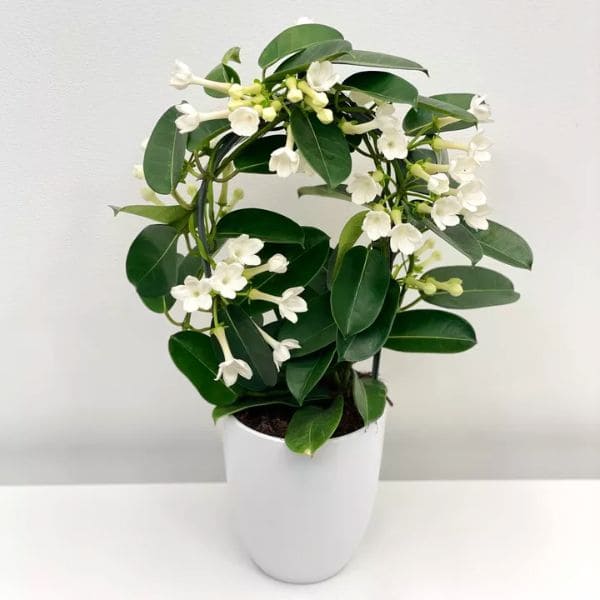
Symbolizing marital happiness, prosperity, and good luck, white stephanotis is a popular choice for wedding bouquets and floral arrangements.
Additionally, stephanotis requires a warm, humid environment to thrive, making it a perfect choice for greenhouses or as a houseplant in cooler climates.
Cosmos (Cosmos bipinnatus)
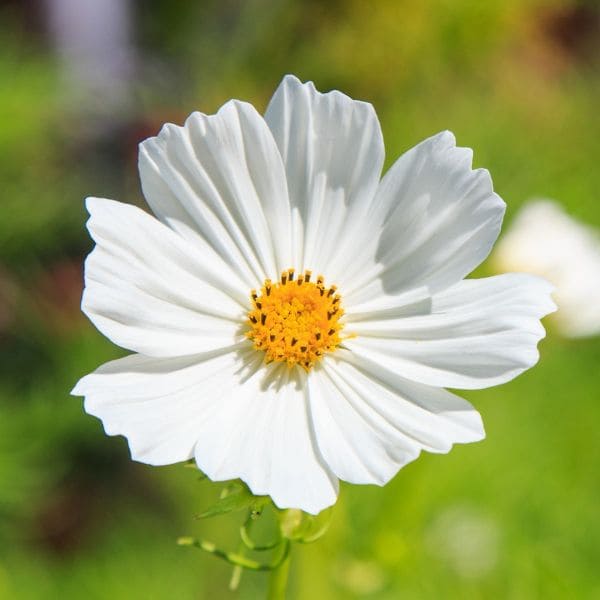
- Plant Type: Annual
- Bloom Time: Summer to early autumn
- Sun Exposure: Full sun
- Soil Requirement: Well-drained, average soil
- USDA Hardiness Zones: 2-11 (annual)
- Native: Mexico
This annual plant is known for its delicate, daisy-like flowers and feathery, fern-like foliage.
White cosmos typically grow to a height of 2-4 feet, with flowers featuring 8-10 broad petals surrounding a central yellow disc.
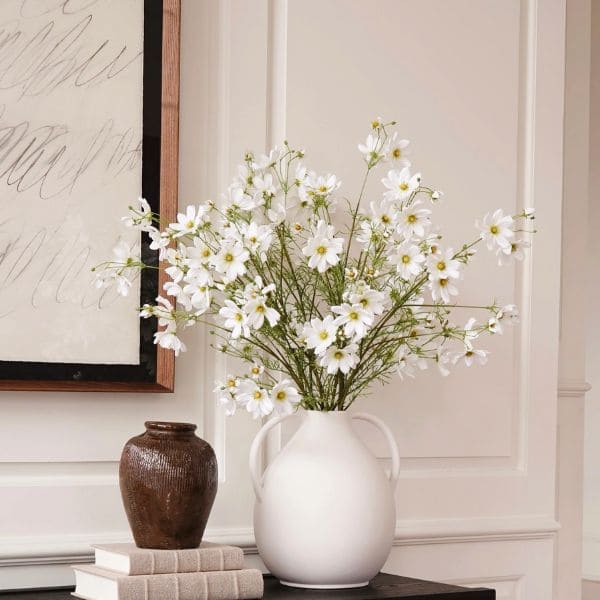
Symbolizing order, peace, and modesty, white cosmos are popular in garden beds, borders, and as cut flowers in floral arrangements.
Moreover, these flowers can attract beneficial insects like bees, butterflies, and ladybugs, which can help with pollination and pest control in your garden.


